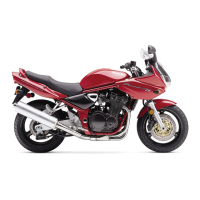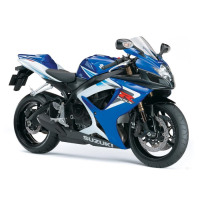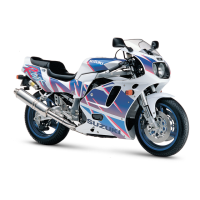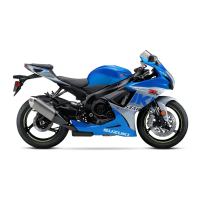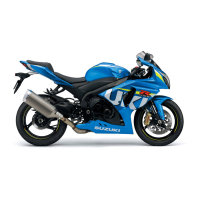
Do you have a question about the Suzuki GSX-R750K1 2001 and is the answer not in the manual?
| Displacement | 749cc |
|---|---|
| Compression Ratio | 12.0:1 |
| Fuel System | Fuel injection |
| Starter | Electric |
| Transmission | 6-speed, constant mesh |
| Final Drive | Chain |
| Rear Brakes | Single hydraulic disc |
| Front Tire | 120/70-ZR17 |
| Rear Tire | 180/55-ZR17 |
| Seat Height | 810 mm |
| Engine Type | 4-stroke, liquid-cooled, inline-four |
| Front Suspension | Inverted telescopic, coil spring |
| Rear Suspension | Link-type, coil spring, oil damped |
| Front Brakes | Dual hydraulic disc |
| Length | 1400 mm |
| Height | 1135 mm |
| Wheelbase | 1400 mm |
| Fuel Capacity | 18 L |
| Bore x Stroke | 72.0 x 46.0 mm (2.83 x 1.81 inches) |
Explains special meanings of signal words like WARNING, CAUTION, and NOTE.
Lists important safety precautions for service mechanics and motorcycle reliability.
Recommends specific types of fuel, engine oil, and coolant for the motorcycle.
Provides detailed technical specifications for engine, transmission, chassis, and electrical systems.
Lists recommended intervals for periodic service work to maintain peak performance.
Describes servicing procedures for items listed in the Periodic Maintenance Chart.
Details inspection and adjustment procedures for valve clearance, including specifications.
Provides procedures for replacing engine oil and oil filter, including amounts and intervals.
Details inspection intervals for brake fluid level and brake pad wear, including DOT 4 specification.
Explains how to perform a compression pressure test to assess the engine's internal condition.
Details the procedure for checking engine oil pressure to indicate the condition of moving parts.
Details the sequential steps for removing the engine from the frame and reinstalling it.
Provides a flowchart outlining the engine disassembly procedure.
Details the removal, disassembly, inspection, and reassembly/installation of the water pump.
Covers crankshaft runout, conrod measurements, and bearing oil clearance checks.
Provides guidelines for reassembling the engine, emphasizing critical steps and torque values.
Provides safety precautions for handling FI components and servicing the system.
Describes the components of the fuel delivery system, including tank, pump, filters, and injectors.
Explains the ECM's composition, function, and the eight programmed maps for engine conditions.
Describes the sequential, four-cylinder injection system and timing determination.
Introduces various sensors like IAP, TP, CKP, CMP, IAT, ECT, AP, and TO sensors.
Lists malfunction codes, detected items, and possible causes for troubleshooting FI system.
Details the removal, disassembly, inspection, and reassembly/installation of the water pump.
Describes the construction of the front fork, listing all components and their torque specifications.
Provides a flowchart for diagnosing common electrical issues, starting with battery problems.
Explains the fully transistorized ignition system, including components and timing control factors.
Provides troubleshooting tables for FI system, engine, cooling, chassis, brakes, and electrical systems.
Lists common engine complaints, symptoms, possible causes, and remedies.
Lists common brake complaints, symptoms, causes, and remedies for power, squeaking, and drags.
Provides troubleshooting for electrical issues like no spark, fouled plugs, generator, and starter problems.
Addresses battery issues like sulfation, running down quickly, and rapid discharge, with remedies.
Lists tightening torque specifications (N·m, kgf·m, lb-ft) for engine, FI system, cooling, and chassis.
Provides detailed service specifications for valve, camshaft, cylinder, piston, conrod, and crankshaft.
Lists service data for valve, camshaft, cylinder, piston, conrod, and crankshaft for the K2 model.
